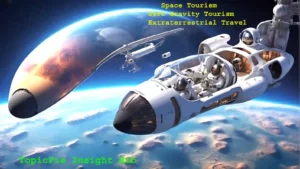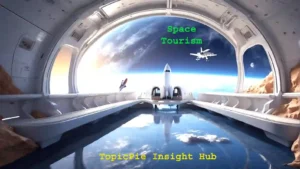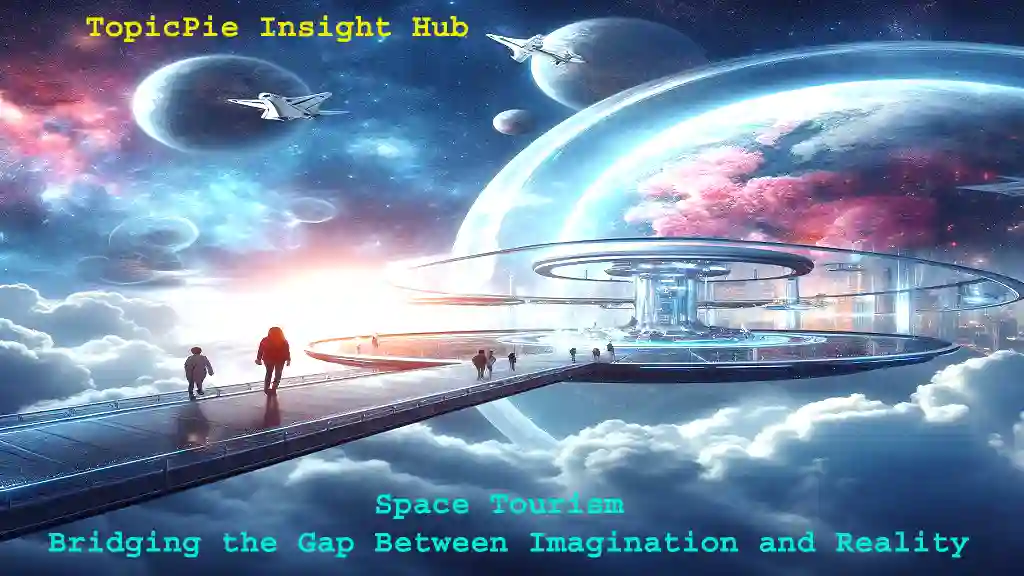In the not-so-distant past, the idea of traveling to space was a distant dream. It was limited to the realms of science fiction and the imaginations of stargazers. However, as we stand on the precipice of a new era, that dream is rapidly transforming into reality. Welcome to the fascinating world of space tourism. Here, the cosmos becomes a playground for adventurers, and the stars a destination for the intrepid.
Space tourism or Zero-Gravity Tourism or Extraterrestrial Travel, a concept that once seemed light-years away, is now an industry on the cusp of a revolution. It’s no longer reserved solely for the elite group of professional astronauts or government-backed missions. Today, civilians are poised to become astronauts in their own right, venturing beyond Earth’s boundaries, not as pioneers but as tourists.
This blog acts as a guiding star in the galaxy of space tourism. It illuminates its evolution, and the exhilarating experiences it offers. It also highlights the major players propelling the cosmic charge and the promising future on the horizon. Space tourism goes beyond mere leisure activities. It embodies human curiosity and represents the next step in the journey to understand and explore the universe.
Buckle up as we embark on a celestial odyssey, bridging the gap between imagination and reality. In this cosmic adventure, we’ll discover the intricacies of space tourism and how it’s transitioning from a dream to a destination for those ready to take the giant leap.

The Rise of Space Tourism:
Space tourism, once a science fiction dream, has rapidly become a transformative industry. This cosmic revolution isn’t just a new chapter in human exploration; it’s a giant leap toward making space accessible to all.
The journey of space tourism can be traced back to the dawn of the space age when Yuri Gagarin became the first human in space in 1961. It was a milestone that ignited humanity’s fascination with the cosmos and led to the moon landing in 1969. While these early missions were government-funded and reserved for astronauts, they sowed the seeds of a future where space could be the playground of the masses.
The turning point came in 2001 when Dennis Tito, an American businessman, became the first private citizen to visit the International Space Station. Tito’s voyage marked the beginning of a new era, demonstrating that space was no longer an exclusive domain of governments and select individuals. It opened the door to commercial space travel for civilians.
Since then, space tourism has been on an upward trajectory. Innovators like Elon Musk, Jeff Bezos, and Richard Branson have invested their fortunes in making space accessible to the public. This newfound interest, coupled with advancements in technology, has made space tourism not just a possibility but a near-term reality.
As we delve deeper into the realm of space tourism, we’ll explore how this industry has evolved from a distant dream to an imminent opportunity, bridging the gap between Earth and the cosmos.
Understanding the Basics of Space Tourism:
Space tourism is more than just a casual vacation to fascinating destinations on Earth. It’s a journey that transcends our planet’s boundaries and takes us to the final frontier. To embark on this adventure, it’s essential to grasp the basics, from what space tourism entails to the various types available.
What is Space Tourism?
Space tourism, in its essence, involves private individuals paying for the privilege of venturing into space. Unlike traditional space missions carried out by professional astronauts on government-funded programs, space tourism opens up the cosmos to civilians who seek a taste of weightlessness and the chance to gaze at our planet from above. It’s the democratization of space exploration, inviting ordinary people to become astronauts.
Different Types of Space Tourism:
Space tourism comes in two primary flavors: suborbital and orbital.
Suborbital Space Tourism: Suborbital flights are a quick and exhilarating introduction to space. Passengers on suborbital missions experience a short journey, typically reaching altitudes of about 100 kilometers. During this brief adventure, they taste weightlessness for a few minutes and witness the curvature of the Earth. Suborbital space tourism is known for its accessibility and shorter duration, making it a great starting point for those eager to explore the cosmos.
Orbital Space Tourism: Orbital flights, on the other hand, offer a more comprehensive space experience. Passengers on orbital missions venture much farther, typically reaching altitudes of around 400 kilometers. This enables them to orbit the Earth, experience prolonged weightlessness, and savor the awe-inspiring beauty of our planet from a unique vantage point. Orbital space tourism offers a deeper immersion into the wonders of space but comes with a more substantial investment of time and resources.
Suborbital vs. Orbital: Exploring the Options

When choosing our space tourism adventure, the decision between suborbital and orbital is pivotal. Suborbital flights are ideal for those seeking a taste of space in a shorter, more affordable journey. These flights are relatively quick, typically lasting under 15 minutes, making them accessible to a broader range of individuals. The cost of a suborbital ticket is in the range of $200,000 to $250,000, a significant but attainable investment for many space enthusiasts.
Orbital space tourism, on the other hand, offers a more extended and immersive experience. Passengers spend several days in space, conducting experiments, and witnessing multiple sunrises and sunsets each day. However, this privilege comes at a higher cost, typically starting at tens of millions of dollars. Orbital space tourism is a longer and more exclusive journey, often attracting individuals with a profound passion for space exploration and a more substantial budget.
Understanding these options is crucial as it allows us to tailor our space tourism experience to our preferences and resources. Whichever path we choose, space tourism offers the chance to bridge the gap between our imagination and the cosmos, granting us the opportunity to become an astronaut in our own right.
The Space Tourism Experience:
The allure of space tourism lies not only in the destination but in the entire experience. From meticulous preparations to the grand finale of returning to Earth, this journey is nothing short of extraordinary. Let’s delve into the four key phases that define the space tourism experience.
Preparing for the Journey:
Space tourism begins long before liftoff. Passengers must undergo intensive training to ensure their safety and readiness for the adventure ahead. This training is as comprehensive as what professional astronauts receive, albeit in a condensed timeframe.
Space tourists embark on a crash course in astronaut essentials, including:
Centrifuge Runs: Participants experience simulated G-forces, helping them prepare for the intense acceleration during launch and reentry.
- Zero-G Flights: A taste of weightlessness is essential for passengers, helping them acclimatize to the sensation of floating in microgravity.
- Scenario-Based Emergency Training: Astronauts and space tourists must be prepared for any contingency. Training includes drills to handle various in-flight emergencies.
System and Procedure Instruction: Understanding the spacecraft’s systems and how to operate them is crucial for a safe journey.
Once this rigorous training is complete, passengers are mentally and physically prepared to become astronauts in their own right.
Launching into Space
The moment of liftoff is both thrilling and nerve-wracking. Space tourists strap into their seats, their hearts racing with anticipation. The rocket or space capsule that will carry them to the cosmos roars to life, and the ground trembles beneath it. The ascent into space is marked by a few intense minutes of noise, vibration, and G-forces that press passengers firmly into their seats.
As the spacecraft hurtles toward the stars, the realization dawns that the dream of space tourism is becoming a reality. For those aboard, it’s a moment of profound significance and achievement.
Life in Space: A Glimpse of Weightlessness
Once in orbit, approximately 250 miles above Earth, space tourists experience a surreal sensation: weightlessness. They can unstrap from their seats and float freely around the cabin, gazing out the window at the breathtaking views of our planet and the cosmos beyond.
One of the most extraordinary aspects of life in space is the altered perception of time. Orbiting the Earth at over 17,000 miles per hour, space tourists witness approximately 16 sunrises and sunsets every day. This constant transformation of light and shadow over the Earth’s surface is a remarkable sight that few on our planet have ever witnessed.
During their time in space, passengers may also participate in conducting scientific experiments, adding to the legacy of human exploration. The experience provides a profound connection to the wonders of the universe and a unique perspective that is both humbling and inspiring.
Returning to Earth: The Grand Finale
As with all good things, the space tourism experience must come to an end. After several days in orbit, it’s time to return to Earth. The spacecraft or space capsule fires its engines to begin the descent, and the journey back is an adventure in itself.
As the spacecraft reenters Earth’s atmosphere, temperatures outside can reach up to 3,000 degrees Fahrenheit due to the intense friction. However, the thermal shielding protects the occupants as they hurtle toward the ground.
Finally, parachutes deploy to slow and stabilize the craft, ensuring a safe landing either on solid ground or in the ocean. This grand finale is the culmination of an extraordinary journey, one that leaves space tourists forever changed by the experience and forever connected to the cosmos.
The space tourism experience is a testament to human ingenuity, curiosity, and the relentless pursuit of exploring the unknown. It’s a voyage that offers a glimpse of the extraordinary, a taste of the cosmic, and a profound connection to the universe beyond our home planet.
Major Companies Pioneering Space Tourism:
In the thrilling landscape of space tourism, several major companies have taken the lead, each with a unique vision and approach to make space travel accessible to the public. These companies are redefining the boundaries of human exploration, enabling individuals from various backgrounds to venture beyond our planet. Let’s explore the trailblazers at the forefront of this cosmic revolution.
SpaceX: Redefining Space Travel
Founded by visionary entrepreneur Elon Musk, SpaceX has been a driving force in revolutionizing space travel. While initially known for its missions to resupply the International Space Station (ISS), SpaceX has set its sights on the future of space tourism. With the Crew Dragon capsule and Falcon 9 rockets, SpaceX is poised to carry tourists on orbital journeys.
One of the most anticipated ventures is the upcoming mission around the moon, set to launch in 2023 with paying customers on board. SpaceX’s commitment to making space travel not just feasible but routine is a defining characteristic of the new space era.
Blue Origin: A Suborbital Vision
Jeff Bezos’ Blue Origin is dedicated to bringing the dream of space tourism to life through suborbital flights. The New Shepard rocket and capsule have undergone successful test flights, with a vision to carry paying customers on suborbital journeys in the near future.
Blue Origin’s approach focuses on short trips to the edge of space, offering passengers a few minutes of weightlessness and stunning views of Earth’s curvature. By focusing on suborbital missions, Blue Origin aims to provide a more accessible and affordable entry point into space tourism.
Virgin Galactic: Making Space Accessible
Sir Richard Branson’s Virgin Galactic has made significant strides in the pursuit of suborbital space tourism. With its SpaceShipTwo system, Virgin Galactic is nearing operational status, with hundreds of reservations already in place for those eager to experience space.
Virgin Galactic’s approach to space tourism combines elegance and adventure, offering a taste of the cosmos while making it accessible to a broader clientele. Test flights with Branson aboard have brought the dream of civilian space travel one step closer to reality.
Boeing and Space Adventures: New Horizons
Boeing, a renowned aerospace company, has teamed up with Space Adventures to offer space tourists a chance to visit the ISS. Using Boeing’s Starliner crew capsule and Atlas V rockets, this collaboration is set to kickstart a new era of orbital space tourism.
While Boeing’s primary focus is on government missions, this partnership with Space Adventures opens doors for civilians to venture into orbit and experience life on the ISS. The integration of space tourism into Boeing’s operations marks a pivotal development in the industry.
Axiom Space: The Commercial Space Station
Axiom Space is taking a bold step by developing the first commercial space station module. While initially catering to professional astronauts, Axiom Space’s vision extends to private citizens seeking the ultimate space adventure.
The company plans to provide individuals with the opportunity to visit the ISS and conduct research while in orbit. This innovative approach promises to create a pathway for space tourists to experience life on a space station, marking a significant leap in the field of space tourism.
Sierra Space: Dream Chaser’s Role
A subsidiary of Sierra Nevada Corp., Sierra Space is developing the Dream Chaser, a reusable space plane. While initially intended for cargo missions, the Dream Chaser holds the potential for crewed missions, including space tourism.
The Dream Chaser’s versatility and reusability could pave the way for affordable and accessible space travel for a broader range of enthusiasts. Sierra Space’s contribution to the industry is a testament to the growing diversity of approaches to space tourism.
World View: The Balloon Perspective
World View offers a unique twist on space tourism by using stratospheric balloons to loft pressurized capsules to high altitudes. While not reaching the technical definition of space, this approach allows passengers to experience dramatic views of Earth’s curvature from over 100,000 feet.
World View’s innovative and imaginative approach provides a different entry point to the wonders of the cosmos. It offers a perspective of our planet that is both awe-inspiring and accessible to a broader audience.
These major companies are pioneers in the rapidly evolving space tourism industry. They turn space travel into a reality, reshaping the concept of an astronaut, and extend an invitation to people from all backgrounds to partake in this cosmic adventure. Each company has a unique vision, ensuring a diverse and promising future for space tourism.
The Promising Future of Space Tourism
The realm of space tourism is on the cusp of a revolution. With exciting developments and innovations, the future of space tourism promises to be accessible, diverse, and awe-inspiring. In this section, we’ll explore the different facets that make this future so promising.
Suborbital Space Tourism: The New Frontier
Suborbital space tourism is poised to become the new frontier in the world of travel. Companies like Blue Origin and Virgin Galactic are diligently working to bring this exhilarating experience to the masses. Short hops to the edge of space offer passengers a few minutes of weightlessness and unparalleled views of Earth.
Ticket prices were once prohibitive. However, they are expected to drop significantly in the coming years. This will make suborbital space tourism more affordable for adventurous travelers. Industry experts estimate that suborbital flights could cost as little as $50,000 per seat by the 2030s, opening the door to an entirely new market of space enthusiasts.
Orbital Space Tourism: Beyond Earth’s Boundaries
While suborbital space tourism is making waves, orbital space tourism continues to be the pinnacle of space exploration. Companies like SpaceX and Axiom Space are planning missions that will take private citizens to the International Space Station (ISS) and even beyond.
SpaceX’s ambitious lunar mission, slated for 2023, promises to be a defining moment in the history of Extraterrestrial Travel. With paying customers set to orbit the moon, the boundaries of what’s possible for civilian space travel are expanding rapidly.
Innovations Shaping the Industry
The future of space tourism is being shaped by a series of remarkable innovations. Reusable rocket and spacecraft technology is reducing launch costs, making space travel more economically viable. As companies perfect their reusable vehicles, the cost of reaching space will decrease, and the industry will become more sustainable.
Larger spacecraft, designed to accommodate hundreds of passengers per flight, are on the horizon. These innovations will increase the capacity for space tourists and enhance the overall experience.
Another exciting development is the prospect of space hotels. Imagine spending a vacation in a luxurious orbiting hotel, with breathtaking views of Earth as your backdrop. Companies are exploring this concept, bringing the dream of staying among the stars closer to reality.
Faster intercontinental suborbital point-to-point travel is another avenue being explored. Space tourism may not be limited to journeys beyond Earth; it could revolutionize global travel, making long-haul flights a thing of the past.
Space Tourism for All: The Accessibility Revolution
Perhaps the most promising aspect of the future of space tourism is the accessibility revolution. As technology advances and demand increases, space travel should see new innovations that open up access to the cosmos.
The dream of extraterrestrial travel is evolving. It’s shifting from a privilege for the ultra-wealthy to an attainable adventure for a broader audience. Companies are committed to making space travel more accessible. They are paving the way for a diverse range of individuals to explore the cosmos.
As the industry continues to grow and evolve, more and more people will realize the dream of gazing back at our home planet. Experiencing weightlessness will also become a reality for a broader audience, as technology and accessibility improve. The promise of the future is that space tourism won’t remain a distant dream; it will bring the stars within humanity’s reach.
Conclusion
In the grand tapestry of human exploration, space tourism is emerging as a brilliant and transformative thread. What was once confined to science fiction is rapidly becoming a reality, as pioneering companies propel us toward the cosmos. The journey we’ve undertaken begins at Earth’s launchpads. It extends to the far reaches of space, a testament to our enduring curiosity and ambition.
As we reflect on the path we’ve traversed in this guide, it’s clear that space tourism is no longer a mere dream. It’s a tangible, exhilarating, and promising venture that promises to bridge the gap between imagination and reality.
The rise of space tourism marks a new era where we redefine the boundaries of exploration. From suborbital flights offering moments of weightlessness to orbital missions that take us beyond Earth’s boundaries, the future is brimming with possibilities. Innovations in technology, accessibility, and sustainability are making Extraterrestrial Travel an option for a broader spectrum of humanity.
The allure of gazing at our home planet from space is captivating. Floating weightlessly amid the stars is a dream. It resonates with our deepest aspirations. This journey is the future of travel. The ordinary citizen becomes an astronaut. The cosmic realm extends our world.
In the years ahead, space tourism will continue to evolve, becoming not just a privilege for the few but an opportunity for the many. It’s a promise that space, the final frontier, will be within reach of all those who dare to dream and explore. The stars are calling, and the future of space tourism is our celestial ticket to answer that cosmic invitation.









Your point of view caught my eye and was very interesting. Thanks. I have a question for you.
Proceed please.